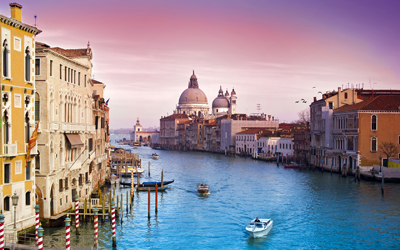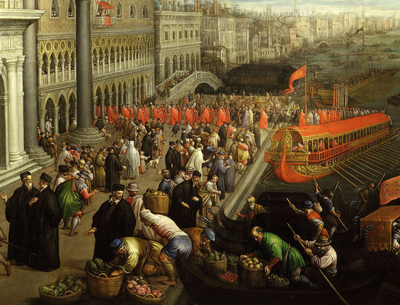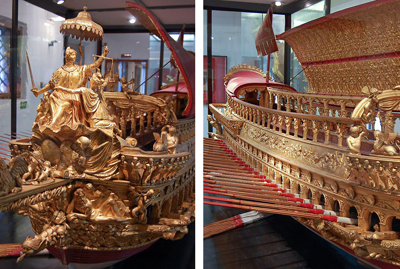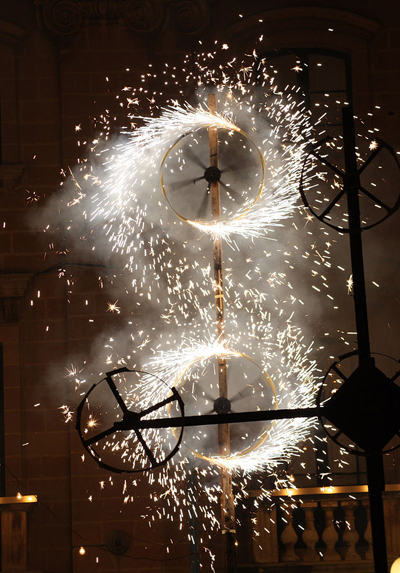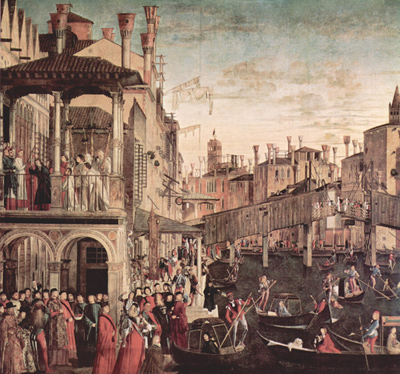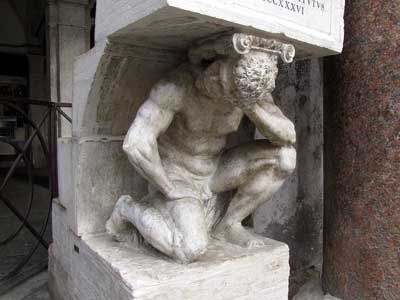So, I’m cleaning the inspiration pics I used for Masks off my computer, and sharing some of the more interesting ones with you. Yesterday’s post was about Venetian homes. Today’s concerns its relationship with the sea.
Venice lives on the water. It has to, considering that it’s made up of 118 small islands, connected by 177 canals. The greatest of the canals is the appropriately named Grand, a snake-shaped waterway that follows the course of an old river. The original settlers of Venice, the Veneti people, lived in stilt houses along the riverbank. After Venice was resettled in the 5th century by people fleeing the Hun invasion, the old river became the center of commerce for a growing city.
It grew fast. By the 9th century, Venice had thrown off its allegiance to Constantinople, the last bastion of the old Roman Empire, and started some serious empire-building of its own. It soon conquered Dalmatia, Cyprus, Crete and large amount of territory on the mainland of Italy. It set up trading centers as far away as Greece on the one hand and Russia on the other. It dominated trade with the Middle East, becoming so well-acquainted with the area that Europeans who wanted to visit there used Venetian merchants as travel agents. By the 12th century, Venice was the leading sea power in the Mediterranean and well on its way to being one of the richest cities in the world.
Much of its success was thanks to its fleet of 3,000 ships. And its fleet was thanks to the greatest shipyard in the world at the time, the Arsenal. It dominated Venetian life, occupying 15% of its land and 10% of its yearly tax revenue. But unlike most taxes, the Arsenal was worth every penny.
Employing 16,000 people at its height, the Arsenal was said to be able to turn out a new galley (an armed trading vessel) in a day. They did this using the world’s first movable assembly line. A new ship would float down a small canal, stopping at stations along the way where workers would assemble different parts of it. The process was much faster than normal shipbuilding, because each group of workers specialized in one area, and naturally became faster at it over time. There wouldn’t be anything else like it in the world until Henry Ford started making Model T’s.
Venice’s empire building is even more impressive when you consider the size of most of their ships. Above is a detail from a Caravaggio painting from the fifteenth century. In the background, you can see the type of long haul ship common at the time. The massive sailing ships of later years, with multiple cabins and decks, were yet to be invented. There was only one small, cramped cabin for passengers, which they all had to share, while the crew slept on the deck (and hoped they didn’t fall off!)
The Venetians were equally adept on the water at home. The pic above is of the bucentaur, the lavish barge created by the doges (Venice’s civic leaders) for state business. A carved, gilded, velvet-covered extravaganza, it was designed to be the most impressive ship on the water and was regularly used to entertain visiting kings and ambassadors. The idea was to overawe visitors with unmistakable proof of Venice’s wealth and power without having to say a word. But while it might have been silent, it wasn’t subtle. Below is a modern recreation of one of the four bucentaurs. Clearly, over the top was not a problem in Venice.
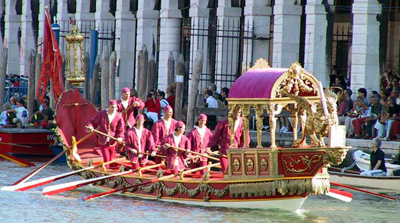
A modern recreation of a fifteenth century gondola. This would not be the sort of gondola you would hire, but more like one a nobleman might keep for his personal use.
But it wasn’t just the doges that moved about on the water in Venice. Everybody did. You didn’t really have a choice, since it was virtually the only way to get anywhere.
When Napoleon conquered the city in the eighteenth century, he filled in a good many canals and made some wide avenues, to more easily move his troops about. But fifteenth century Venice was a warren of tiny streets, some of them so narrow that only one person could move through at a time. Others were blocked by new construction or had been turned into ominous-looking tunnels by the upper levels of surrounding houses, which people built outward to give themselves more elbow room. So, if you wanted to get anywhere in Mircea’s era, you took a boat.
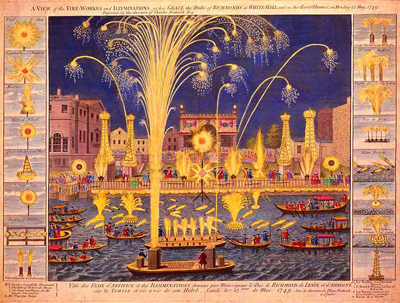
A VIEW of the FIRE-WORKES and ILLUMINATIONS at his GRACE the Duke of RICHMOND’S at WHITEHALL and on the River Thames on Monday 15 May 1749.
Of course, the water was also used for things besides transport. As the city’s main large, open space, it became a natural place for leisure time activities, with regattas, boating parties and fireworks all taking place there. The above fireworks display isn’t from Venice, but the Italians were the first people in Europe to manufacture fireworks, and were far ahead of most other countries in perfecting them. Accounts from the 15th and 16th centuries indicate that this sort of display was typical for Italy.
Fun fact: The multicolored fireworks common today weren’t invented until the 19th century. Maybe that was the reason that the emphasis in the Renaissance was on ground based fireworks like the Catherine wheel below, rather than huge aerial shows.
And finally, if you have canals everywhere, you need bridges to go over them. The two halves of Venice are linked across the Grand Canal by the Rialto Bridge. Today, it’s a massive stone bridge lined with shops. But in the mid-fifteenth century it was wood, with the center able to be raised and lowered to accommodate tall ships.
The painting above shows the Rialto Bridge in Mircea’s time. You can also see some of the more common types of gondolas in front. Fun fact: some gondoliers were in the pay of Venice’s 11,000 or so prostitutes, and would often take unsuspecting young men to the brothels rather than where they had asked to go. Or so the guys said afterwards!
The Rialto, as the only bridge between the two halves of Venice and the location of the city’s biggest shopping district, was the center of life in the 15th century. It had a large fish market, where the city’s fishing fleet deposited much of their daily catch, as well as a market for vegetables and fruits grown on the mainland. It was also the end of a very strange race.
Jail space was at a premium in a city built on water, which could obviously have no dungeons. So only the very worst offenders could expect to be locked up. But what about petty thieves and people who had committed minor offenses? Fines were popular, but there was another alternative: a race from San Marco Square, the main square of the city, to the Rialto.
Now, that’s only about 3/10ths of a mile, hardly much of a punishment . . . right? Well, there was one more small thing, namely that the locals were allowed to hit the runners with sticks, whips or whatever else happened to be handy, all along the way. The beating only stopped when the sufferer reached the hunchback. Of course, by then, they were probably a little hunchbacked, too!
More tomorrow.

